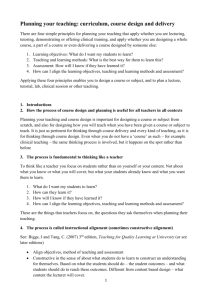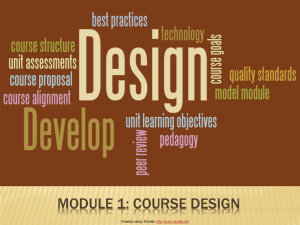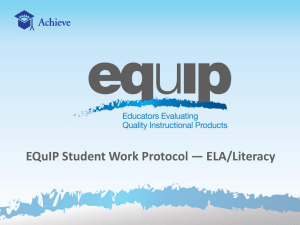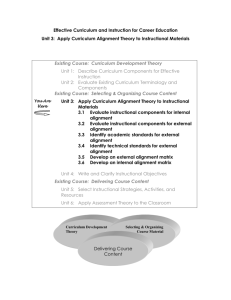A Simple Curriculum Alignment Activity
advertisement
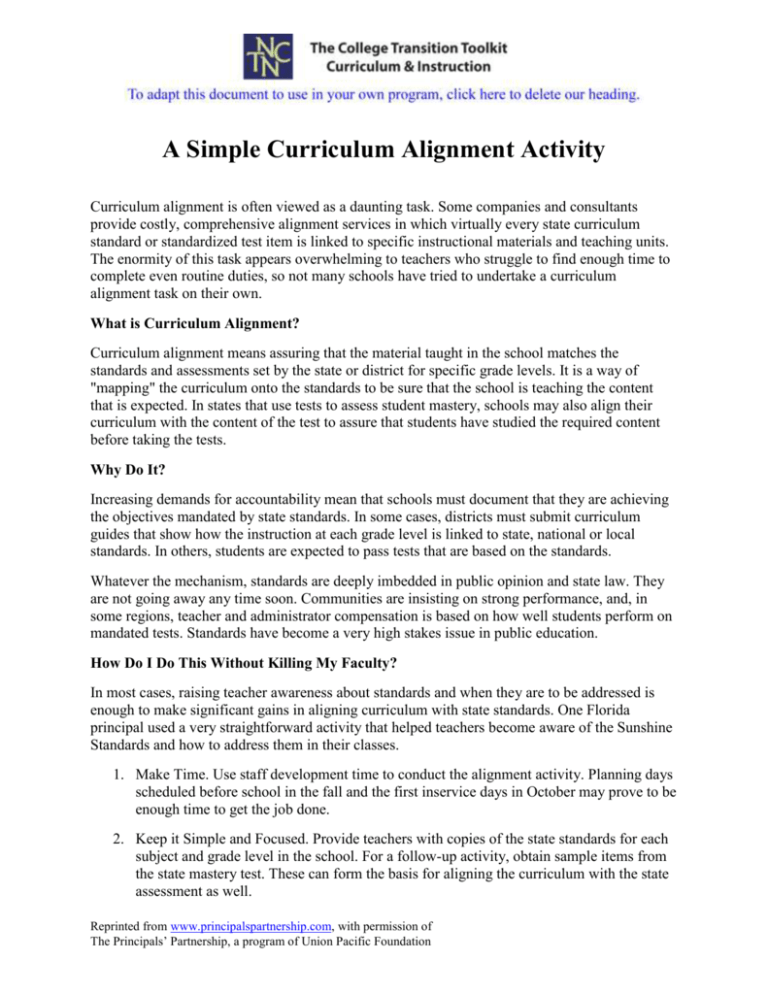
A Simple Curriculum Alignment Activity Curriculum alignment is often viewed as a daunting task. Some companies and consultants provide costly, comprehensive alignment services in which virtually every state curriculum standard or standardized test item is linked to specific instructional materials and teaching units. The enormity of this task appears overwhelming to teachers who struggle to find enough time to complete even routine duties, so not many schools have tried to undertake a curriculum alignment task on their own. What is Curriculum Alignment? Curriculum alignment means assuring that the material taught in the school matches the standards and assessments set by the state or district for specific grade levels. It is a way of "mapping" the curriculum onto the standards to be sure that the school is teaching the content that is expected. In states that use tests to assess student mastery, schools may also align their curriculum with the content of the test to assure that students have studied the required content before taking the tests. Why Do It? Increasing demands for accountability mean that schools must document that they are achieving the objectives mandated by state standards. In some cases, districts must submit curriculum guides that show how the instruction at each grade level is linked to state, national or local standards. In others, students are expected to pass tests that are based on the standards. Whatever the mechanism, standards are deeply imbedded in public opinion and state law. They are not going away any time soon. Communities are insisting on strong performance, and, in some regions, teacher and administrator compensation is based on how well students perform on mandated tests. Standards have become a very high stakes issue in public education. How Do I Do This Without Killing My Faculty? In most cases, raising teacher awareness about standards and when they are to be addressed is enough to make significant gains in aligning curriculum with state standards. One Florida principal used a very straightforward activity that helped teachers become aware of the Sunshine Standards and how to address them in their classes. 1. Make Time. Use staff development time to conduct the alignment activity. Planning days scheduled before school in the fall and the first inservice days in October may prove to be enough time to get the job done. 2. Keep it Simple and Focused. Provide teachers with copies of the state standards for each subject and grade level in the school. For a follow-up activity, obtain sample items from the state mastery test. These can form the basis for aligning the curriculum with the state assessment as well. Reprinted from www.principalspartnership.com, with permission of The Principals’ Partnership, a program of Union Pacific Foundation 3. Make it Realistic. Assemble teams of teachers by subject area, grades 9-12. (Depending on the testing cycle, it may be good to include middle school teachers as well.) Have each teacher bring to the workshop (1) copies of the teacher's edition of textbooks they use, (2) unit plans, and (3) supplementary instructional materials. Focus on the material they use most of the time, rather than abstract curriculum guides or plans. 4. Raise Awareness and Keep it Raised. Give each teacher a set of highlighters in different colors. Ask them to page through their instructional materials, keeping the standards beside them, and highlight the sections of the materials that coincided with the state standards. For example, if a standard calls for students to be able to "identify the causes of the Great Depression," the teacher highlights that topic and content in his or her text or other teaching material. By highlighting the teachers' editions, teachers are continually reminded of standards-based content while planning daily instruction. 5. Decide When, Where, How Much and How Often. After linking content to standards, ask each subject matter group to review the standards and, for each one, determine at which grade level and in what unit (1) the standard is introduced, (2) the standard is emphasized, and (3) the standard is assessed. This helps the team assure that all standards are taught and assessed at some point during the high school grades. In fact, it also identifies areas that are neglected or over-emphasized as well, and allows the teachers to make more balanced decisions about their curriculum. 6. Think Interdisciplinary. After the content specialists have done their work, seek help from other faculty. Department chairs review the content standards from other disciplines and identify ways that their department might support one another's instruction. For example, one reading standard may require that students distinguish fact from inference. The reading teacher can provide tips to the other teachers on how to incorporate that skill into their normal reading assignments and discussions. Teachers then highlight their teachers' editions with another color to identify standards from other subject areas that they can reinforce in their own classes. 7. Share Ideas, Tips and Practices. At every team and faculty meeting ask teachers to share a strategy or tip they found effective in teaching a specific standard or skill. Or, following a classroom observation, the principal might ask a teacher to do a "Five Minute Inservice" on an effective approach they were using in class. 8. Don't Forget the Test. A follow up activity involves repeating a similar process with sample items from the state mastery test. Teachers are asked to review all the items and identify where in the curriculum the student would have learned the material needed to be successful on each item. This helps to identify gaps as well as places where one content area can be bolstered by teaching in another subject. The net effect of this kind of planning is that teachers are able to map their existing curriculum onto state standards and tests. It does not require a huge curriculum revision effort or massive infusions of money and time. It simply requires a structured plan of action and a useful departure from normal "staff development" activities. It also has the additional benefits of opening up the curriculum to thorough internal review, stimulating dialog across disciplines on how to approach standards in an interdisciplinary way, and sharing effective instructional strategies. It is a good example of how a faculty can take the "problem" of standards-based accountability and turn it into solid curriculum planning. Reprinted from www.principalspartnership.com, with permission of The Principals’ Partnership, a program of Union Pacific Foundation Resources for Curriculum Alignment AOL@school For Teachers provides lesson plans linked to the state standards for each state. http://school.aol.com/teachers/lesson_plans.adp Curriculum Alignment Module from the National School Boards' Association "Tool Kit" http://www.nsba.org/sbot/toolkit/curric.html Alignment Information from the Florida Department of Educationhttp://osi.fsu.edu/waveseries/htmlversions/wave9.htm Written by J. Howard Johnson, Ph.D., College of Education University of South Florida, Tampa FL Reprinted from www.principalspartnership.com, with permission of The Principals’ Partnership, a program of Union Pacific Foundation
